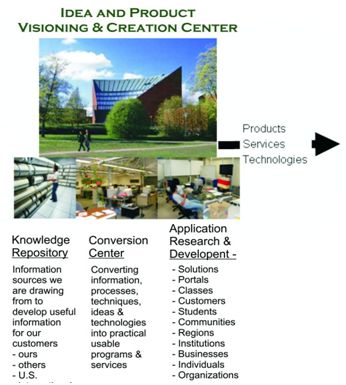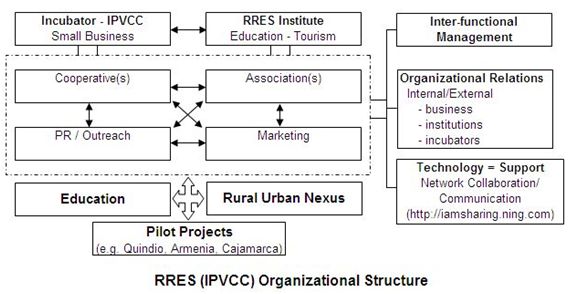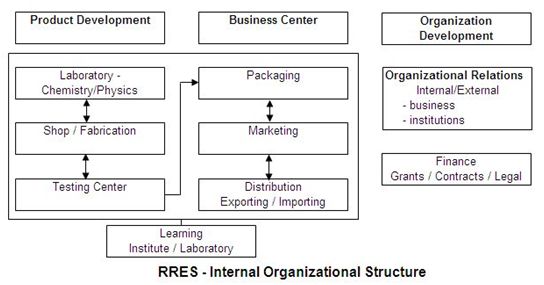Action Center 4) Idea and Product Visioning & Creation Center (IPVCC)
This section describes a second critical tangible “center” for the RRES, that which empowers entrepreneurship. In combination with the Institute, this part of the strategy is one that brings a tangible asset which results in many benefits. Focusing on supporting the process of generating new ideas and products, there is a cooperative nature grounded in the ultimate aim to support regional communities, businesses, organizations, but ultimately individuals. The model is designed in a way for it to be adaptable. It includes a practical arrangement for the organization, its functions, the steps to implementation, and an overview of the technologies that will facilitate completion.
A Proposed Structure for the IPVCC – three legs: Business, Social, Infrastructure Introduction a Cooperative Model
In the world today there are three primary types of organizations: business (financial), non-profit (social good) and institution/ government (infrastructure and public services). Usually, these three types of organizations end up attempting to support all three of these functions within their organization, but do not succeed because the main focus of the organization is on one aspect and are not designed to support the other activities. A balanced organization should give adequate importance to each function. For example, if infrastructural support falters, the success of the organization will be diminished. Likewise, if the “quality of life” (social) diminishes then the whole organism suffers. Finally, if adequate financial resources (business) are not generated and sustained, there will be a breakdown of the whole organization (community, region).

Figure 3: Idea and Product Visioning & Creation Center (IPVCC)
It appears that a blending of the primary functions of these three entities would make for a more efficient organization. The institution would be responsible for managing the infrastructure and the services of the Cooperative. The business would be responsible for the fiscal and financial (marketing, business development) aspects and the continued monetary support/management for the other two legs of the organization. The non-profit portion of the organization would be responsible for the programs that ensure the continued vitality of the region, such as education, social and other community empowerment programs.
Figure 3 provides a schematic for the overarching components of the Idea and Product Visioning & Creation Center (IPVCC). The foci, or outputs, of the IPVCC will be on small business (products, services) creation and support and tourism (large arrow on right).The tourism strategy, because it is fairly it would substantially increase the length of this proposal, will not be described in detail, but can be provided if desired.
Tourism is by far the most well developed of our regional development strategies. Dr. Skadberg is in the final stages of his new book “VISION – We Are Re-Creating the World, A resource manual, or “tool-box”, for rural development with a foundation on environmental sustainability and community enhancement.” Tourism is discussed in great detail in this book and the JRLU and Jamaica can draw from these ideas and the examples provided in the case studies. The diagram below shows the initial structure and flows of activities and organizational functions of the IPVCC. The items “Education” and the “Rural Urban Nexus” identify the first opportunity spaces and the way the process will begin will be through the successful launching and implementation of “pilot projects.”

Diagram 12: Functional Structure (internal & external) for the RRES Idea and Product Visioning & Creation Center
This description only provides a brief outline of what we see as the critical functions necessary and the steps to realize the “vision” of the IPVCC. This is a “living” document so elements can be added and expanded and adaptation will occur often, depending on the organic, evolutionary nature of this “systems” endeavor:
Facilities necessary to accomplish our Vision
The kinds of facilities that we will need to realize this vision are depicted in Diagram 12. Both Diagrams 12 and 13 are based on the activities occurring for several products that were being proposed in Colombia South America. One of our team was an inventor that had numerous “green” products and processes to bring to market (e.g. bio-ethanol). Thus, there was a focus on the creation of the product development laboratory, testing center and shop outfitted with all the necessary tools to manufacture or fabricate first production (test versions) of the various products.
Additionally, our understanding for the success of a regional initiative is to have a physical place where community members can come and actually see the products and gain an understanding of progress for our initiative. To fulfill this we would need to acquire a complex of buildings and include a product and demonstration showroom. We also want to have a “business development” section: Marketing, business planning, packaging. This is linked to a concept developed by Dr. Skadberg called the “hybridized community diversified cooperative” (HCDC).
Also necessary will be computer infrastructure for supporting online application development, a GIS laboratory, hyperspectral data storage, manipulation and product creation.

Diagram 13: Internal Organizational Structure for the RRES Product and Idea Visioning & Creation Center Diagram 14 below illustrates to the flow of an idea or product from conception to delivery to the market place. The center box, is a sort of “black box” representing the flow of activities between the product creation section (Incubation) and the business side of the IPVCC. This box is depicted in organizational details in Diagrams 12 and 13. One important additional aspect is the feedback loops from the products and services in the market place. These provide intelligence and continual quality control to assure that the process is functioning effectively and efficiently.

Diagram 14: Flow diagram of ideas moving through the RRES Idea and Product Visioning and Creation Center
All rights reserved GBCI, SMI & JRLU Team © 2010